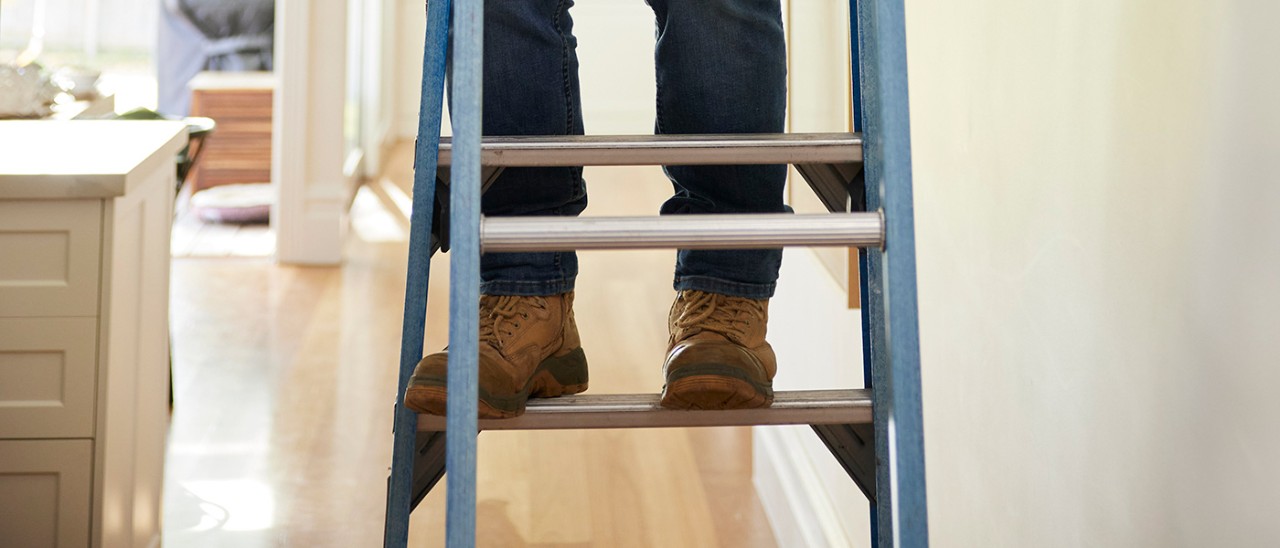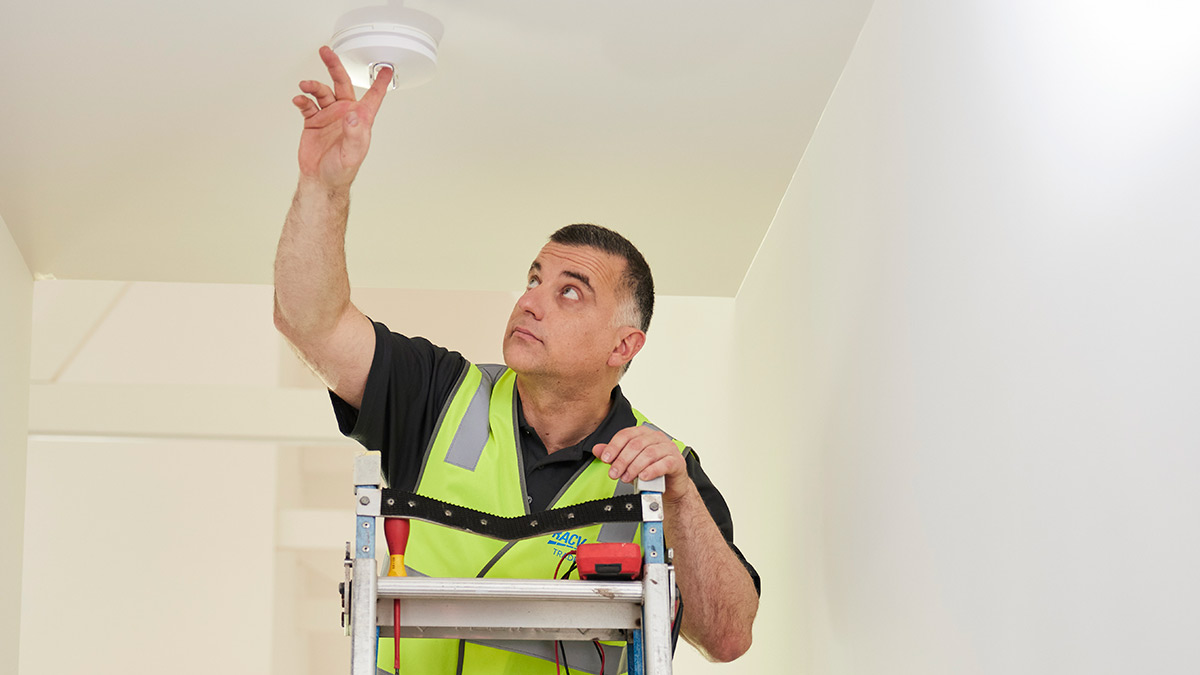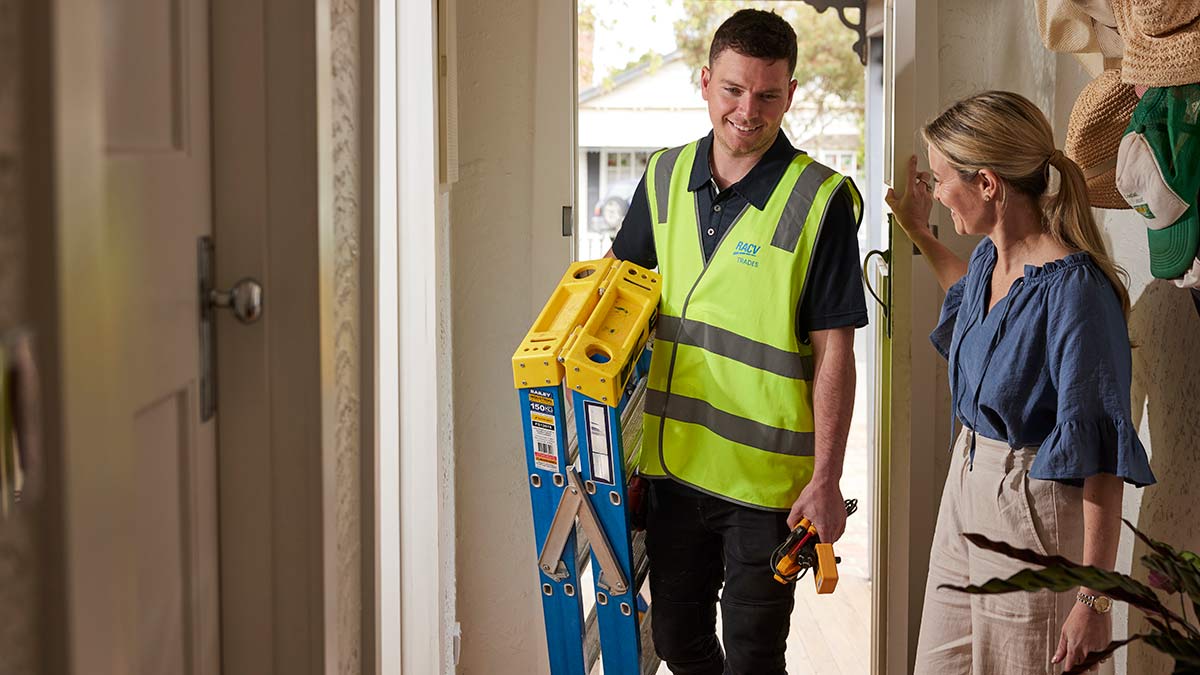How often should I service my air conditioner? How do I increase the lifespan of my air conditioning unit? Here’s what you need to know ahead of summer from RACV Trades.
How to use a ladder safely around the home to prevent falls

Ladder falls in and around the home have risen sharply over the past five years, with more than 6000 Victorians requiring a trip to hospital. Here’s a guide to staying safe when a job with a ladder is required.
From gutter cleaning to changing lightbulbs, ladders are used for many DIY home maintenance tasks around the home. But falls from ladders can cause serious injuries, as reflected in the latest Victorian data, which shows a sharp increase in presentations to hospital emergency departments due to such incidents at home.
Here’s why you need to take ladder safety more seriously, and a guide to how to prevent falls from occurring.
In this article
How serious is the issue of ladder falls at home?
Ladder falls resulting in injury have increased by a significant 21 per cent over a five-year period in Victoria from 2019/20 to 2023/24, according to the Monash University Accident Research Centre’s Victorian Injury Surveillance Unit.
That represents 6098 presentations to Victorian public hospital emergency departments over five years, all related to do-it-yourself activities where the ladder fall occurred at home while the person was not doing paid work. Last financial year there were 1340 falls recorded.
The vast majority of DIY ladder falls were among males (76.5%), while more than half of the falls (56%) involved people aged between 50 and 74. The injuries increased steadily with each age bracket up to 69 years, rising sharply into double-digit percentages for those aged 50-54 years (10%), 55-59 (11.6%), 60-64 (12.2%) and 65-69 (12.5%). There were also 416 ladder falls recorded for those aged over 80.
Fractures (40.7%) were the most common injury sustained from ladder falls, followed by dislocations, sprains and strains (13%). Injuries to the ankle and foot were the most prevalent (14.4%), followed by the wrist and hand (14%), the head (12.2%) and thorax (10.8%).
Also significant is the fact that 48 per cent of those who fell from a ladder were admitted to hospital for further treatment, underlining the severity of injuries sustained from ladder falls.
More: The 10 worst home safety hazards (and how to fix them)

When replacing the battery in a smoke alarm, use the right size of ladder, make sure it's stable and position it so the alarm can be easily reached.
Why do ladder falls occur in the home>
RACV Head of Trades Kieran Davies says that complacency is dangerous when it comes to home maintenance tasks involving ladders. Often ladder falls occur when people overreach, do not keep three points of contact, position their ladder on an unsupportive surface, use the wrong type of ladder for the task or overestimate their ability.
“People taking on tasks from a height need to make sure they are capable and have positioned their ladder safely, because even a small trip or a stumble can result in an injury,” Davies says. “Australians are simply not taking their safety on a ladder into account as much as they should be.”
More: Guide to home fire safety and hazard prevention
When to hire a professional for ladder jobs
With many chores and tasks around the home like cleaning gutters, changing lightbulbs and trimming hedges involving the use of a ladder, some jobs are better off left to trained professionals.
The Victorian government’s Better Health Channel advises that it may be unsafe to use a ladder if you experience dizziness, are feeling faint or light-headed, have low vision or trouble seeing, have difficulties with your co-ordination, balance or strength, of if you’re at risk of side effects from medicine.
“If the job requires specialist equipment, training or a licence, is dangerous or you think may be beyond your skill or physical ability, you should get a professional to do it for you,” Davies says.
“It’s really important to be honest with yourself about your equipment, abilities and, importantly, your age. If you’re unsure or don’t feel comfortable completing the task, call in a professional. Even if it’s a job you used to do yourself, it’s just not worth the risk.”

A professional tradesperson is recommended if you don't have safe equipment or someone to hold and support the ladder.
Safe use of ladders – checklist and handy tips
While professional help for bigger jobs is recommended, you may find yourself doing the odd DIY project at home. Follow these rules to keep yourself as safe as possible when using a ladder.
Choose the right ladder for the job
Having the right ladder for the job is paramount. Any ladder you use should be labelled with its Australian Standard AS/NZS 1892 approval. Check that the ladder is in good working order before you use it, with no broken, damaged or missing parts. Don’t use a rusty ladder and clean off any grease or other slippery materials from the steps.
“The ladder should have working safety locks and non-slip feet,” Davies says. “It also needs to be the right height and weight rating for the job you are using it for. If you can only reach by standing on the top rung, then the ladder is too short for the job and you should stop. Remember that the weight rating includes any tools and supplies you’re carrying.”
Work with someone who can help you
Another set of eyes on the task can help spot potential hazards, help out if the position of the ladder needs to change, or provide immediate first aid in case of an accident.
“It is always safer to have someone else with you to hold and support the ladder,” says Davies.
Set your ladder up properly
Ladder positioning is also important. Always set up your ladder on a firm, level surface that isn’t wet or slippery.
“Ensure that you can set your ladder up somewhere that won’t be knocked by doors or windows, but that is also close enough to your work area that you won’t be reaching or leaning,” Davies advises. “It can be really tempting to reach out to the side that extra bit with the paint brush rather than get down and move your ladder, but this can be extremely dangerous.”
If you’re using an extension ladder, ensure it extends at least one metre over the top of the surface it rests against and make sure to secure it at the top. You should also follow the 1:4 rule: for every four metres of ladder height, the ladder base should be positioned one metre away from the structure.
Avoid wet, windy or very hot weather conditions
The weather is also a major factor when it comes to ladder safety. Extremely hot temperatures could make you feel faint or dizzy, causing you to lose your balance at height. Wet or windy conditions could cause your ladder to slip or fall.
“Take the time to assess your job and the environment when working at height outside,” Davies says. “Don’t work if it’s too hot, wet or windy, and make sure you are wearing appropriate non-slip footwear.”
Climb the ladder appropriately and with care
When climbing a ladder, wear enclosed and slip-resistant shoes. Do not wear thongs and sandals, because they do not provide the grip and support you need. Make sure your shoelaces are securely tied and that your pant legs don’t extend underneath your shoes.
When climbing, face the ladder and stay in the centre of the rails. Maintain three points of contact at all times by holding the ladder with both hands as you climb and carrying any tools in a toolbelt.
On a step ladder, only climb to the second rung from the top and never stand on the pail shelf, spreaders or back section.
On an extension ladder, only climb to the third rung from the top. Never climb above the point where the ladder touches the wall or vertical support.
More: Regular home safety and maintenance checks to keep your home in top shape


